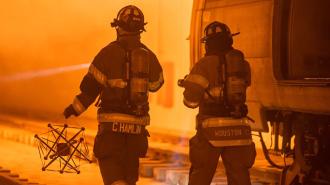The designer of a new type of rover for NASA has found a way to employ her space robots on Earth — by modifying them to help first responders enter disaster zones.
The challenge: Robots have played a huge role in space exploration, studying the surfaces of Mars, the moon, and even an asteroid in previously impossible detail.
Deploying space robots is complicated, though. To get the Perseverance rover to Mars, NASA had to nestle the robot inside a protective lander. After slowing its descent with a parachute and rockets, the lander used a cable system to lower the robot onto the surface of the Red Planet.
That was not only hugely complex, it also meant a lot of extra weight, space, and cost to transport Percy and its lander to Mars.
The idea: In 2014, NASA awarded UC Berkeley researcher Alice Agogino $500,000 to develop space robots that wouldn’t need a separate lander to reach the surface of another object in space.
“The robot itself is the landing device.”
Terry Fong
Her idea was to create a sphere-shaped skeleton of rods and elastic cables, based on the design principle of tension integrity, or “tensegrity” — the concept behind some head-scratching “anti-gravity” structures you might see on YouTube or TikTok.
The robot’s important sensors and instruments would reside in the center of this ball, and when dropped, the force of the impact would be spread across the skeleton, keeping the vital payload safe.
“[T]he robot itself is the landing device,” said Terry Fong, chief roboticist in the Intelligent Robotics Group at NASA’s Ames Research Center. “It could survive a fall from very high up and keep going.”
Once on the ground, the joints of the rod and cable system could adjust to roll the robot in any direction. During transportation in space, the skeleton could be folded flat to save room.
“It’s expensive and difficult to launch mass into space, so you want more of it to be used beyond landing, on the surface with scientific instrumentation and other payloads,” said Fong.
Terrestrial tech: While NASA is still considering when and how to deploy these rolling space robots, stationary versions are already making an impact here on Earth through Squishy Robotics, a company Agogino founded to commercialize the tech.
“We thought, wow, if we can do this on the moon, we should be able to do it on planet Earth and save some lives,” said Agogino.
Disaster response is one way they can save lives. Several pilot projects with firefighters have shown how the robots could be fitted with cameras and tiny chemical gas sensors and dropped in disaster areas via drones to help responders better understand the situation.
“We thought, wow, if we can do this on the moon, we should be able to do it on planet Earth and save some lives.”
Alice Agogino
If data from the robots reveals that hazardous material gear isn’t necessary, for example, it could save up to an hour of prep time, meaning a quicker response.
Squishy is also courting military customers. It envisions the robots being dropped into dangerous areas from drones, helicopters, or low-flying planes (the bots can survive falls of up to 1,000 feet). Cameras and sensors could then collect data without risking soldiers’ safety.
“We believe these robots could serve unique purposes for space,” said Fong. “[Agogino] obviously saw a way to also have a major impact on Earth.”
We’d love to hear from you! If you have a comment about this article or if you have a tip for a future Freethink story, please email us at [email protected].




